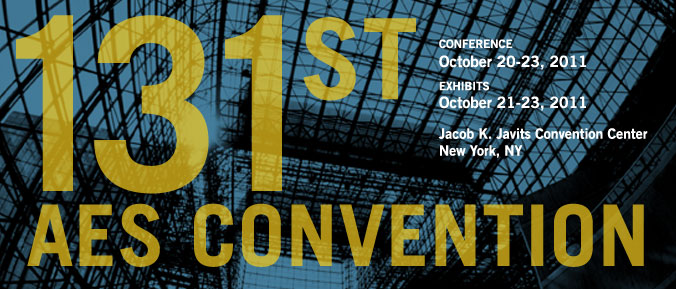
AES New York 2011
Paper Session P8
P8 - Loudness Measurement and Perception
Thursday, October 20, 4:30 pm — 6:30 pm (Room: 1E07)
Chair:
Dan Harris, Sennheiser Technology and Innovation
P8-1 Effect of Horizontal Diffusivity on Loudness—Densil Cabrera, Luis Miranda, University of Sydney - Sydney, NSW, Australia
This paper examines how the spatial characteristics of a sound field affect its loudness. In an experiment, listeners adjusted the gain of stimuli so as to match the loudness of a reference stimulus. The experiment was conducted using binaural stimuli presented over headphones—using stimuli that simulated the sound from eight sound sources evenly distributed in a circle around the listener. Four degrees of diffusivity were tested, ranging from a single active sound source, to all eight sources producing decorrelated sound with identical power spectra. Four power spectra were tested: broadband pink noise, and low-, mid-, and high-frequency bandpass-filtered pink noise. The paper finds that in modeling the binaural loudness summation of the diffuse stimuli, a binaural gain constant about 1 or 2 dB greater than that of the non-diffuse stimuli provides the least error.
Convention Paper 8487 (Purchase now)
P8-2 Locating the Missing 6 dB by Loudness Calibration of Binaural Synthesis—Florian Völk, Hugo Fastl, AG Technische Akustik, MMK, Technische Universität München - Munich, Germany
Binaural synthesis is a sound reproduction technology based on the convolution of sound signals with impulse responses defined between a source and a listener's eardrums. The convolution products are typically presented by headphones. For perceptual verification, subjects traditionally remove the headphones to listen to the corresponding real scenario, which is cumbersome and requires a pause between the stimuli. In this paper loudness adjustments are presented using a method that allows for direct comparison by defining the reference scene for a listener wearing headphones. Influences of different headphones and equalization procedures are discussed and an explanation for the difference in auditory canal pressure between headphone and loudspeaker reproduction at the same loudness commonly referred to as the missing 6 dB is deduced.
Convention Paper 8488 (Purchase now)
P8-3 Difference between the EBU R-128 Meter Recommendation and Human Subjective Loudness Perception—Fabian Begnert, Håkan Ekman, Jan Berg, Luleå University of Technology - Piteå, Sweden
The vast loudness span of broadcast sound can be reduced by the use of loudness meters. In an ideal case, the measured and the perceived loudness would be equal. A loudness meter fulfilling the EBU R-128 recommendation was investigated for its correspondence with perceived loudness. Several sound stimuli with large loudness differences representing five different types of broadcast program material were normalized to have equal meter measured loudness level. Subjects listened to pair-wise presentations of the normalized stimuli, which they subsequently set to have equal perceived loudness. The settings were recorded and analyzed. The results show that the normalization yields both equal as well as different perceived loudness between program types. The maximum difference was ±2.82 dB.
Convention Paper 8489 (Purchase now)
P8-4 A Novel Multi-Stage Loudness Control Algorithm for Audio Processing—Balaji Vodapally, Brijesh Singh Tiwari, ATC Labs - Noida, India; Deepen Sinha, ATC Labs - NJ, USA
Modern audio broadcast processors are designed to provide an audio with consistent loudness within a specified dynamic range. In general a tight control over the processed audio level is provided by the Automatic Gain Control (AGC) mechanism. Most of the other processing functions are tuned for a pre-defined signal level; this arises the need for multi-stage loudness control. This paper presents the gain control mechanism employed in various stages of the proposed multi-stage Audio Loudness Control (MALC) and the interaction between various stages. We also present results which explain how the proposed scheme provides better control over loudness against the signal level. The paper also emphasizes the importance of frequency weighing based loudness measure.
Convention Paper 8490 (Purchase now)
Information Last Updated: 20111005, mei

